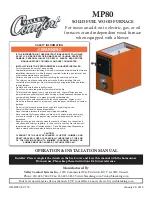
44
C
OMFORT
N
ET
C
OMPATIBLE
F
URNACE
WITH
N
ON
-C
OMFORT
N
ET
S
INGLE
-S
TAGE
A
IR
C
ONDITIONER
Four wires are required between the furnace and thermostat.
Two wires are required between the furnace control and single
stage air conditioner. For this system configuration, the “Y1”
terminal on the integrated furnace control becomes an output
rather than an input. The “Y1” connection to the outdoor unit
is made using both 4-position thermostat connectors in the
CTK0* kit. Remove the red keying tabs from the on-board
connector block and position both 4-position connector such
that “1”, “2”, “R”, “C”, and “Y1” positions are filled.
A 24 vac input may be applied to the G terminal of the
modulating furnace control board to operate the indoor
blower to support an HRV / ERV. The 24 vac source must
originate from the R terminal of furnace.
1
2
R C
Furnace Integrated
Control Module
CTK0*
Thermostat
G
W1 W2
Y1
Y2
O
1
2
R
C
4-Pin (X2), 7 pin, or 9 pin Connector
24 vac “G” Input to Furnace Integrated
Control Module from ERV, HRV or similar device
24 VAC "G" Input
1
2
R C
C
Y
ComfortNet Compatible
Furnace Integrated
Control Module
CTK0*
Thermostat
Non-ComfortNet Compatible
Single Stage AC
G
W1 W2
Y1
Y2
O
1
2
R
C
4-Position Connectors
from CTK0*
Thermostat Kit
System Wiring between Furnace and Non-Communicating
Compatible Single Stage Air Conditioner
Pressure Switch Calibration Routine
The modulating fur-
nace must go through a pressure switch calibration routine
before it can begin its first heat cycle. This is performed
automatically by the furnace and requires no action on the
part of the installer other than to have the system compo-
nents installed completely and correctly. On the initial power
up, or any time that power to the furnace is switched off
then back on again and a call for heat is applied, the fur-
nace will go through a calibration routine. During the cali-
bration routine the IFC runs the induced draft blower at
different speeds to determine the opening and closing points
of the pressure switches. It records this information and
uses it as reference points for determining the draft in-
ducer speeds for all gas input rates from 35% - 100%.
Before beginning a calibration routine, the IFC will check
that both pressure switches are in the open position.
·
The IFC powers the draft inducer at a predetermined
speed and checks to see if the LPS has closed.
·
If the LPS is not closed the IFC will increase the draft
inducer RPM in small steps until it detects a closed
LPS.
•
The IFC then begins to reduce RPM until it detects
that the HPS is open.
•
It records the RPM point where the HPS went open.
•
The IFC then adds a predetermined amount of draft
inducer RPM to both the recorded points.
•
These new RPM points are the draft inducer speed
for 35% (lowest input rate) and 100% (highest input
rate).
The IFC then is able to control draft inducer speed
through the IFC-VFD throughout the entire range of
modulating operation.
Time
RPM
RPM 1
RPM 2
Closed
LPS
Closed
HPS
100% (Max)
35% (Minimum)
Inducer Calibration Routine
A
BBREVIATIONS
AND
D
EFINITIONS
•
IFC
: Integrated furnace control
•
HSI
: Hot surface element
•
LPS
: Low pressure switch
•
IDB
: Induced draft blower
•
HPS
: High pressure switch
•
Variable Frequency Drive
(VFD)
: Control of the in-
duced draft blower is carried out by Variable Frequency
Drive. By varying the voltage and frequency to the
draft inducer, the RPM can be controlled. A section of
the IFC is dedicated to this task.
•
Trial for Ignition Period (TFI)
: The period of time
between initiation of gas flow and the action to shut
off the gas flow in the event of failure to establish
proof of the supervised ignition source or the super-
vised main burner flame.
•
Gas Valve Sequence Period:
The total period of time
of gas flow starting from the first initiation of gas to
the final action to shut off the gas before going to
lockout.
OPERATION
















































